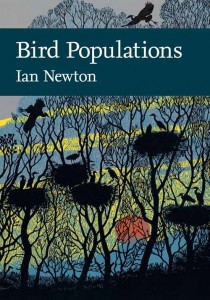 Prof Ian Newton FRS has been described as the UK’s greatest living ornithologist and there is nothing in this book to dent that assessment.
Prof Ian Newton FRS has been described as the UK’s greatest living ornithologist and there is nothing in this book to dent that assessment.
In his clear and precise way, Ian Newton explains the factors that affect, determine and regulate bird population levels. There are plenty of examples which illustrate the general principles.
As Ian writes – much of our understanding of animal population regulation is based on studies of birds although the principles are much more widely applicable.
This is not the easiest of reads, but that’s because compensatory mortality and density dependence are not the easiest of subjects. Ian provides the most accessible account of those difficult subjects that the birdwatcher eager to understand whether sparrowhawks are wiping out songbirds, for example, is likely to find (and, they aren’t – see page 165).
The fact that bird populations go up and down but often within quite narrow limits compared with what might be possible is such a commonplace of our lives that we tend not to realise that it is as interesting as it really is. A pair of Blue Tits can lay 10 eggs and rear all the young successfully so why aren’t we knee-deep in Blue Tits (pecking at our ankles and shins) after a few years? Thank heavens for disease, predators, cold winter nights, interspecific competition, lack of nesting sites and winter food shortages I say!As Blue Tit numbers increase then some of these mortality factors bite harder and if Blue Tit populations decline then they bite less hard (on average) – that’s population regulation through density dependence. And you only die once – if the Sparrowhawk gets you then the winter food shortage can’t – in fact, your death has made life a tiny bit easier for everyone else when the food bottleneck arrives. And if we wipe out all the Sparrowhawks, as we did over large parts of the country, then we still won’t be knee deep in parids as that winter food bottleneck only lets about the same number through. Would you rather be ripped apart by a Sparrowhawk or starve to death in February?
Along the way you will learn about the impacts of climate change, fisheries, regulated hunting, unregulated persecution, poisoning from lead shot and pesticides on bird species that you have seen in your days’ birdwatching.
Clarity, precision and economy are the keys to Ian Newton’s writing style – there aren’t flourishes or jokes in here. But that doesn’t mean it is dull. Nature is so wonderful that a clear explanation of what happens, how it happens and why it happens is fascinating. And there are some great snippets, too. Every time I hear or see a Treecreeper I will now remember that wood ants compete with them for food – Treecreepers do better when wood ants aren’t present.
This is a very good book if you want to understand the principles and if you want some cracking illustrations of those principles linked to birds you know and love.
Bird Populations by Ian Newton is published as a New Naturalist by William Collins and is available on Amazon as is Mark Avery’s Fighting for Birds.
[registration_form]
Glad to see that the New Naturalist is keeping up the tradition of its archive with authoritative books on nature in its many forms.
Matt – thank you and welcome!
It’s a good hefty sized book,useful to bang the head of anyone blaming sparrowhawk,buzzards etc for population declines!These people will obviously not find the time to read it unfortunately.
My favourite section was about birds ability to build which muscle group was best to avoid the relevent threat.
Slightly disappointed that the GWCT had so much input,obviously they have done lots of research relevant to the book,but they never study the impact millions of non native jungle fowl have on the environment!
Managed Hunting is the shortest chapter in the book.The new Bird Atlas quotes Watson et al,There has been little research on the impacts of released birds on native species,but there is some evidence that shooting operations based on large-scale releases of Red legged Partridge could be implicated in local extinctions of Grey Partridges.
Still a great book,it just means I give it 9/10 rather than a10.
Charles – welcome and thank you.
Received Bird Populations as a Christmas present! A fascinating and essential read for those interested in the dynamics of a balanced population. As a scientist Ian Newton would be expected to look at all the research done on his subject and his reference section runs to 56 pages. A book well within the remit of the New Naturalist series.
I’m looking forward to hearing both Ian and your goodself, Mark, at the Berks and Oxon BTO Conference on March 1st. May take his book along for Ian to sign! Already got a signed copy of Fighting for Birds!
Richard – Ian’s signature is much scratchier than mine – but so much more valuable!
Sounds like it would be a good addition to the recommended reading for my ecology students (along with Fighting for Birds of course!) – thank you Mark
If it is part of the NN series it,s bound to be good.